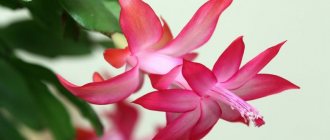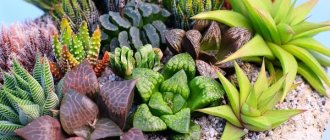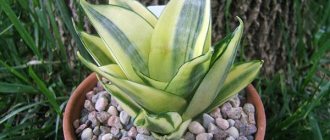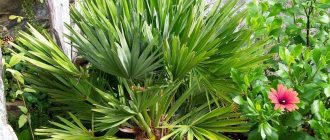Rhipsalis belongs to the cactus family, but outwardly it resembles a cactus very vaguely.
And in general, it’s hard to imagine a more unusual succulent, because it grows not in a distant hot desert, but in the humid tropical forests of distant Brazil, and instead of sharp thorns it has soft hairs. And the uniqueness of the plant does not end there. Let's find out more about him.
Under natural conditions, rhipsalis settles on old trees, tightly clinging to branches and bark with its aerial roots. In addition to trees, it grows on wet rocks: the soil in this case is the remains of organic matter that collect in rock crevices. Habitat: Madagascar, Sri Lanka, Central Africa and Brazil. At home, rapsalis is easy to care for and can be propagated by seeds and cuttings without much difficulty.
Varieties and photos
Below are photos and descriptions of rhipsalis species suitable for propagation and care at home.
Cassuta (empty-fruited) (Rhipsalis cassutha)
Ampelous appearance, with soft rounded shoots consisting of segments and bright red small fruits. The shoots reach a length of 2-3 meters and are highly branched . The flowers are small, white and odorless. The photo below shows Rhipsalis Cassuta:
Hairy (Rhipsalis capilliformis)
Unlike cassuta, this variety has short shoots - only 50-60 cm in length, but also consists of oval flat segments similar to leaves. The variety is epiphytic. Blooms with small white buds. You can see what the Volosovidny variety looks like in the photo below:
Pilocarpa (Rhipsalis pilocarpa)
The stems look like hard tubes covered with yellow hair. They reach a length of 50-60 cm. The variety is capable of blooming several times a year. In the photo below is the rhipsalis variety Pilocarpa:
Common growing questions
Does rhipsalis have spines? The twig is characterized by bare stems, without thorns. Some varieties have soft whitish fibers on the surface. The pilocarp rod is covered with yellowish hairs.
Which pot is better? The pot for the plant should be selected in accordance with the natural habitat conditions. The cactus is most often represented by an epiphytic plant that has a superficial root system. In this regard, you need to select a shallow pot for it. The container should be wide and slightly larger than the previous pot.
What is the lifespan of a flower? In indoor floriculture, with proper care, a flower can live for several decades. The cause of death of the twig is diseases, pests and violation of living conditions.
The home cactus is easy to care for, so every flower lover can keep it at home. Hanging varieties will be an excellent decoration for any corner of the apartment, and lush flowering will make the green shoots even more decorative.
Care
Priming
It is easy to buy at any flower shop - it is a universal soil for growing succulents and cacti.
You can make it yourself from the following components:
- river sand, peat soil, leaf soil and turf - in equal parts;
- humus and garden soil, coarse sand, peat - also in equal parts;
- peat, humus and leaf soil (equal parts), a handful of charcoal and finely chopped sphagnum moss.
For drainage, use small sea pebbles, broken red bricks or expanded clay. The layer should be at least 1/4 of the pot.
Do not forget to calcine the soil in the oven or treat it with a weak solution of potassium permanganate - this will help destroy the pest larvae.
Top dressing
Fertilizers can be applied from March to October - this is the time when rhipsalis is actively growing. Choose liquid mineral fertilizer for succulents and cacti. The recommended frequency is once every 2 weeks, after watering. If special fertilizer cannot be obtained, buy any flower food, but in this case you will need to reduce the permitted dosage by 2 times. If you keep rhipsalis in a cool room during wintering (from October to March), you do not need to apply fertilizer.
Excess nitrogen negatively affects the condition of the plant - keep this in mind.
Lighting
Rhipsalis was brought to our region from tropical forests, so it does not tolerate direct sun.
If you leave the plant on a south window, it will quickly die, so only western and eastern ones! But even there the plant will need to be shaded.
However, even on a northern window, rhipsalis is able to grow and maintain an attractive appearance , but only with the organization of additional lighting.
Temperature
At temperatures from +18 to +25 degrees, rhipsalis will be quite comfortable, but do not forget that if you give your green pet a few months to rest, it will look even more beautiful. This is done as follows: the pot with the plant is transferred to a cool (+15-17 degrees) room and left there until spring, without bothering with fertilizing and frequent watering. Lower temperatures cause the development of diseases and often lead to the death of the crop.
However, even without wintering, rhipsalis is able to grow well - so don’t worry if there is no opportunity for wintering.
Watering and humidity
The peculiarity of tropical forests is high air humidity. It is difficult to organize such an atmosphere in an ordinary apartment, but it is quite possible. Firstly, place the pot with rhipsalis on a tray with wet expanded clay or pebbles , and secondly, give your cactus a warm shower once a month, and spray it with a spray bottle once a day.
Transfer
Replant young plants every spring for the first 3 years, then every 3-4 years.
If the rhipsalis has grown greatly, there is no need to replant it at all, but only remove the top layer of soil and replace it with a new one. For replanting, select a new container - wide, but shallow (after all, the roots of the plant are located close to the surface). Transplantation is carried out using the transshipment method. The new soil is loose and light, neutral or slightly acidic in reaction.
Features of the plant
Rhipsalis is an epiphytic shrub that has the following structural features:
- abundant branching, shoot height can reach up to 1 meter with a width of several millimeters;
- aerial root system located close to the soil surface;
- arthropod shoots, the shape of which can vary from round to flat and ribbed;
- the presence of light hair on the ground part of the plant, the absence of spines;
- the presence of areoles on the shoots;
- small flowers of yellow, pinkish, white or orange tones;
- small berry-shaped fruits with sticky hair of black, white or pink color.
Bloom
You can admire the blooming of rhipsalis in late winter - early spring. Flowers dot the bush like stars in the firmament : they are painted in all shades of pink and white, and their petals are velvety to the touch and slightly pointed. The fruits are shaped like gooseberries, just as juicy, with dark seeds inside.
As soon as buds appear on the cactus, it should not be moved from place to place and the pot should not be turned over. Otherwise, the buds will fall off and you won’t see the flowers. But continue to care as usual.
This photo shows rhipsalis blooming:
Reproduction
Seeds
Propagation by seeds is rarely carried out, because half of the seedlings simply do not appear. Please note that the material must be fresh.
- Soak the seeds in warm purified water with a small amount of potassium permanganate (for 3-4 hours).
- Sow the seeds in a mixture of peat and sand to a depth of no more than 1 cm. Cover the container with polyethylene and wait for rooting. Be sure to make several holes in the film for air, and moisten the soil with a spray bottle. Don't let it dry out!
- As soon as the seedling reaches 2-3 cm, transplant it into a separate container. Since young plants are very weak, do not leave them in direct sunlight, and loosen the soil more often.
Cuttings
The best propagation option is cuttings.
- Cut off a shoot 12-16 cm long from a healthy bush. Powder the cut area with activated charcoal or charcoal and dry it.
- Plant the cuttings in a mixture of peat and sand, moisten it and cover with glass or cling film. You can add support or lean the cutting against the wall of the pot. For germination, you need to maintain a temperature of +23-25 degrees, ventilate the greenhouse daily and spray it with water.
- After a month and a half, when the plant has roots, plant it in a separate pot.
Possible problems
The main problem when growing rhipsalis is the difficulty of maintaining the necessary climatic conditions - humidity, light, watering.
When watering, you should ensure that there is no “standing” water in the pot . Humidity is maintained by regular spraying. Illumination is maintained by growing the plant in western or eastern windows, where sunlight does not burn the stems.
Doesn't grow well
Lack of lighting slows down growth. To solve the problem, you need to ensure that the plant receives daily sunlight at an oblique angle. In addition, high temperatures negatively affect growth. It is worth ensuring the optimal recommended temperature regime.
Pests and diseases
Diseases rarely affect rhipsalis and almost always due to the owner’s oversight.
- Yellow coloration of the edges of the segments, pallor and slow growth indicate a lack of light.
- Have the shoots lost their elasticity and brightness? You obviously flooded your cactus and the roots began to rot. Try to treat it: take it out of the pot and cut off the damaged areas with a sharp blade, sprinkle the cut area with crushed activated carbon and transplant the plant into a fresh substrate. This procedure quite often benefits ripsalis.
- If a rhipsalis flower dries, its leaves decrease in size and fall off, the shape of the buds changes - it is affected by chlorosis. The cause of the disease may be a lack of nutrients (magnesium, iron, nitrogen, sulfur, calcium), an incorrectly selected substrate, or the use of poor quality water for irrigation. Transplant the plant into new soil with an acidity of 5-5.5 pH and water it with water with the addition of citric acid, and from time to time treat the above-ground part with fertilizer containing iron in chelated form.
The most common pests are red spider mites and scale insects. To begin, remove all pests with a cotton swab moistened with soapy water, then wash the flower in the shower and let it dry.
The next stage: treatment with either a folk remedy or a special preparation. If there are few insects, try the first option. For example, a decoction of cyclamen roots (50 g per 500 ml of water) or an infusion of onions (200 g of onion in a bucket of warm water, leave for 12 hours, strain and process immediately). A good effect is from an alcohol solution, specifically ammonia, which only needs 30 ml (they do not spray the leaves with it, but wipe the affected areas).
If the damage is severe, use insecticides: Actellik, Fitoverm, Aktara, Apollo.
Differences between rhipsalis and hatiora
Both hatiora and rhipsalis belong to the same family - cactaceae, and are strikingly similar to each other from a young age. Mature plants are somewhat easier to distinguish . Firstly, they have different shoots: in hatiora they are erect, while in rhipsalis they hang down. Secondly, the segments that make up the stems are of different lengths: in hatiora they are short, in rhipsalis they are much longer.
And the last difference is in the buds. Hatiora flowers are large, bloom only at the ends of the segments, and are colored pink, red or yellow. In rhipsalis, they are small (no more than 2 cm in diameter), white or with a yellow tint.
Botanical description
Rhipsalis are highly branching epiphytic shrubs, a characteristic feature of which is the presence of aerial roots. Plants of all species of the genus are covered with pubescence, and none have spines. The stems of rhipsalis are drooping, leaf-shaped, segmented, ribbed in cross-section, rounded, or flat. Areoles are located on the surface of the stems. The flowers of plants of this genus are small, actinomorphic, with a white, yellow, orange or pale pink corolla. They can be located along the entire length of the stem or only at the tip of the shoot. The plants' juicy, berry-like fruits are about the size of gooseberries and can be white, black or pink.
Signs and superstitions
There are many signs associated with this cactus, and most of them promise not the most pleasant changes. For example, it is believed that families break up because of it, and some esotericists do not advise keeping it in rooms where a man spends a lot of time. There is no reason to comment on a situation in which superstition defeats common sense, just like the information that rhipsalis is poisonous.
If a cactus is in the house of an unmarried girl, it promises her a quick wedding. In the house of a married woman, it promises the birth of a child: dark flowers - a boy, light flowers - a daughter.
If you already have children, the family can expect major purchases or replenishment of your wallet . By placing rhipsalis in the hallway, you will protect it from bad people and negativity.
It is also believed that cacti kill partners’ sexual attraction to each other, and males begin to reach for the bottle: the more flowers appear on the plant, the more vigorously the person drinks. If you want to give a cactus, choose a flowering one with soft spines, otherwise your relationship with the person will worsen. When choosing where to place a cactus, consider:
- Standing on a desktop, the cactus will absorb fatigue and irritation;
- In the kitchen - energy from family disagreements and quarrels;
- A cactus growing in the hallway will scare away bad people from your doorstep.
Interior use
Young rhipsalis are placed in small flowerpots on window sills, stands or tables.
Small and original bushes attract the eyes of guests and delight the owners. And blooming rhipsalis can surprise even those people who do not have a special love for indoor plants.
Large specimens with long shoots are hung near the window or placed in pots on a high stand. This will allow the stems to hang freely and grow. This decorative element will help decorate even the most boring interior.
Often gardeners take large pots outside or onto the balcony and decorate verandas and patios with plants.
The main thing is to take into account that rhipsalis does not tolerate direct sunlight and can be damaged by rain.
Therefore, the pots need to be placed in a shelter.
Photo gallery
vetkinsad
ingadarenskaya
katerinailinich92
vika1345
design.its.my.life
succulents_tver69











